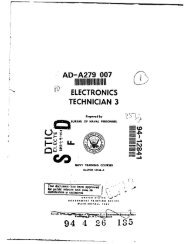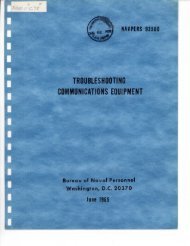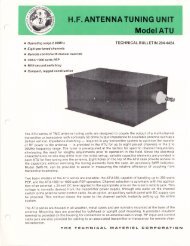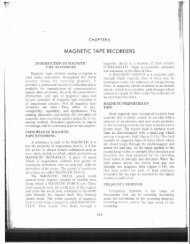L - VIR History
L - VIR History
L - VIR History
You also want an ePaper? Increase the reach of your titles
YUMPU automatically turns print PDFs into web optimized ePapers that Google loves.
ELECTRONIC CIRCUITS NAVSHIPS<br />
the previous checks foil to locate the trouble, the circuit<br />
supplying the plate voltage is probably at foult.<br />
Lor Output. A lo,^ output -~o,uld lormally be caused<br />
by a defectj,,e or weak VI, or o low filament or plote volt-<br />
oqe, or lf the i-f ond r-f tsnk circlits ore no! tuned to the<br />
proper freq~encies. A ;:eck local oscillator voltoge cln<br />
cause a low output. Check the flloment and plate voltages<br />
wlth a VnM. If they art. not riornnl, refer to the procedure<br />
in the previous paragraph. If they ore normal, check the<br />
amplitude of the loco1 oscillator signol. If it is low,<br />
check C3 with an incircuit copocitor checker. If the out-<br />
put is still low, the trouble is probably in the local oscil-<br />
lator circuit.<br />
Distorted Output. A distorted output can be caused<br />
by a defect in nearly any component in thecircuit. With an<br />
oscillascope, check far an r-f siqnd on Cqe secondary<br />
winding to TI. If the r-f sign01 is not present, check the<br />
windings of T1 with an ohmmeter for continuity. Should<br />
the windings not be defective, the trouble lies in the pre-<br />
ceeding stages and the mixer is probably not defective.<br />
If the signol is present on the secondary winding of T1,<br />
check for the presence of the local oscillator signal on<br />
the high side of C3. If it is not present, the loco1 oscillo-<br />
tor is at fault. If it is present, both the I-f and local<br />
oscillator signals should be present on the control grid of<br />
V1. If the local oscillator signal is not present, C3 is de-<br />
fective. If the r-f signal is not present, C2 is defective.<br />
If bath the r-f and local oscillotor signals are present on<br />
the control qrid of V1, Tube V1 is probably defective. If<br />
the output is still distorted, check the plote and sneen<br />
voltages with a VTVM. If both voltages are low, check<br />
the outplt of the plate voltoge supply. If it is low, the<br />
trouble lies in the plate supply. If it is normal, and the<br />
screen voltage is low, check R2 with an ohmmeter, and<br />
C4 and C5 with an in-circuit capacitor checker. If the plate<br />
voltage is low, check C6 with an in-circuit capacitor checker<br />
and the primary winding of T2 with an ohmmeter. If the out-<br />
put is still not present, check the secondary windinq of T2<br />
with on ohmmeter.<br />
PENTAGRID MIXER<br />
APPLICATION.<br />
The pentaqrid mixer IS used in modern superheterodyne<br />
receivers 0s o frequency converter. Incoming r-f s~gnals<br />
are combined wlth signals iron! .I local oscillotor to prm<br />
duce an intermediate frequer:~; (i-f).<br />
CHARACTERISTICS.<br />
Offers qood selectivity.<br />
Serves both os a frequenq converter md o hizh qain<br />
amplifier.<br />
Siqnal-to-noise rotio is poor.<br />
Requires o separate local oscillator to supply the iet<br />
erodyning voltage.<br />
Uses two input control q ds to provide electron mu-<br />
plinc.<br />
CHANGE 2<br />
0967-000-0120 FREQUENCY CONVERTERS<br />
Operates with either cnthode-self, flned, or ovc bias<br />
voltage.<br />
CIRCUIT ANALYSIS.<br />
General. Tne function01 operation of the pentaqrid<br />
mixer is very similar to !hot of other mixer circuits discussed<br />
previously in this hmdbook. R-f and oscillator<br />
voltoges ore injected into the tube a d added olgebrclcolly.<br />
The fundomertal ireqljen-~s, along vrith their swm and<br />
difference frequencies, appear ocros: the outout circuit.<br />
The output circuit is a parallel resonant tank, tuned to the<br />
i-f. The desired I-f sional is transformer coupled into the<br />
next stage.<br />
The prlmary difference between the pentamid mlxer circuit<br />
and other mixer circuits is the input arrangement. In<br />
the diode, triode, md pentode nlxer the r-f md oscillator<br />
wltoges are inserted on the same tube element, allowinq<br />
for greater ~nteraction between input signals. In the pentogrid<br />
mixer, r-f and oscillotor signals ore inserted on seporate<br />
control grids, isoloted from ear5 other and the plote by<br />
screen grids. Coz;eq'~endy, the frequnq pulling effects<br />
md signal interocticn, cormon to other mixer circuits, is<br />
virtually eliminated.<br />
Circuit Operotion. Before discussinq ooeration of the<br />
pentogrid mixer it ..will be helpful to review :he operation of<br />
the pentagrid tube.<br />
The pentagrid tube consists of a plote, cothode, filaments<br />
and five gr~ds, hence the name pentogrid. Two of<br />
the grids ore used as control grids (GI and G3), two are used<br />
as screen grids (G2 ond G4), and the fifth is used as o<br />
suppressor grid. For all procticol purposes the gain of<br />
the pentagr~d tube is compcroble to that of the pentode,<br />
however the inuoductian of an extro screen grid increases<br />
the partition noise, and consequently, the circsit noise.<br />
The screen qrids are operated at a positive voltaqe and<br />
serve as the occeleratinq anodes for electrons leovinq the<br />
cathode. However, the electrons strike the plate of the<br />
tube wlth such force that they tnunci off (semndory emission)<br />
and form a spcce chorqe around the positive sneen<br />
qrid (G3).<br />
The space charge greatly limits the plate voltoqe swinq,<br />
so a negative grid (G5) is placed between screen and plate,<br />
md its negative charge diverts electrons jock to :he plote.<br />
By following the above discassion it con be seen that<br />
the pentagrid tube plote current is made independent of<br />
plate voltage. In fact, tile plote voltage may smng as low<br />
as, or lower thm, tk,~ screen voltoge ..xithout serious loss<br />
of amplifier qoir capobil~ties. In rnixer clrcuits jnin (qr)<br />
is referred to os "con,,ersicn transmnductance" ond rep<br />
resents the quotient of i-f octput current divided by r-f<br />
input voltage; a:, conversion trunsconductance = Iit/Eri.<br />
In pentagrid tubes con.Jerslon trarscond~ctance may run<br />
as high as 500 micromhos.<br />
In the mixer circuits previously discussed, such as the<br />
triode ond pentode mixer, the r-f and oscillotor siqnols ore<br />
injected on th.e some control grid. Tnus the r-f input circuit<br />
is "seen" by both inp~ts cnd stray mupllnq induces<br />
oscillator detuning, or !req'~ency pulllnc. In pertaqrid






